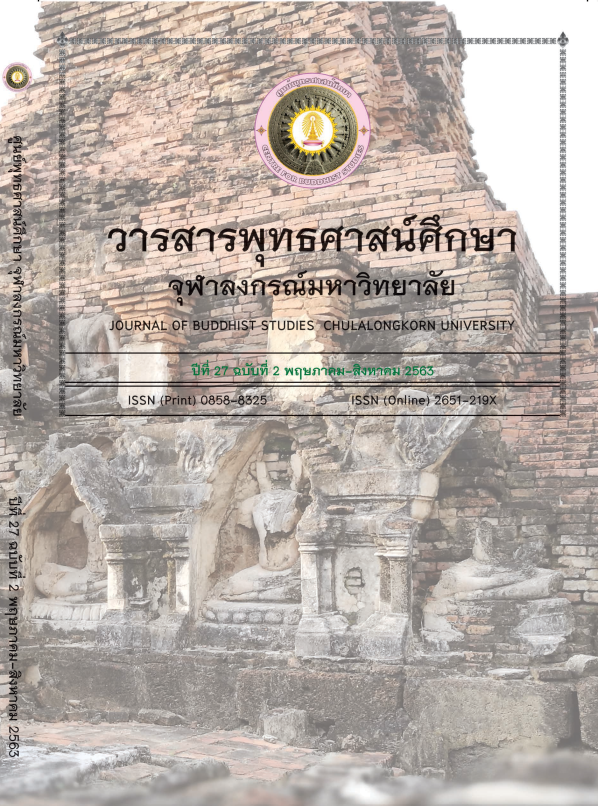The Thai Translation of biography of Kang senghui in Gāosēng zhuàn (1)
Invoking on the Relics of Buddha in the Time of Sūn Quán During the Three Kingdoms Period
Keywords:
Kāng Sēnghuì, Gāosēng zhuàn, Sūn QuànAbstract
The Gāosēng zhuàn, or Lives of Eminent Monks, written around 530 A.D. by the monk Huìjiǎo (慧皎), is one of the most important works dealing with the history of Chinese Buddhism from 67-519 A.D. The scripture contains 257 biographies of prominent monks as well as more than 200 biographies of subordinate monks and upāsakas. These biographies are divided into ten categories, the first of which – the one that contains 35 biographies of great contributors to translating the Sutra – Huìjiǎo placed great emphasis on. The authors attempt to study one of the figures in this category, i.e. Kāng Sēnghuì, who lived in the Three Kingdoms period. Kāng Sēnghuì’s biography was detailed in the periods of two different rulers: during the reign of Sūn Quàn, and during the reign of Sūn Hào.
In this paper, the authors focus on the study and translation of Kāng Sēnghuì’s biography during the reign of Sūn Quàn. The study found that before Kāng Sēnghuì began translating the scripture to diffuse the Buddha's teachings, he was determined to found the first Buddhist temple in Jiànyè (建鄴), and devoted his life to invoking the Buddha’s relics to gain official ermission from Sūn Quán to construct the temple, stupa, and to propagate the Buddhist teachings.
Downloads
References
ฉัตรสุมาลย์ กบิลสิงห์. (8 กุมภาพันธ์ 2562). เยือนวัดม้าขาว. มติชนสุดสัปดาห์. สืบค้นจาก https://www.matichonweekly.com/column/article_169100
ซิว ซูหลุน. (2549). ถังซำจั๋ง จดหมายเหตุการเดินทางสู่ดินแดนตะวันตกของมหาราชวงศ์ถัง (พิมพ์ครั้งที่ 2). กรุงเทพฯ: สำนักพิมพ์มติชน.
ผาสุข อินทราวุธ. (2543). พุทธปฏิมาฝ่ายมหายาน. กรุงเทพฯ: ภาควิชาโบราณคดี คณะโบราณคดี มหาวิทยาลัยศิลปากร.
พระคลัง (หน), เจ้าพระยา. (ผู้แปล). (2559). สามก๊กฉบับเจ้าพระยาพระคลัง (หน). กรุงเทพฯ: สำนักพิมพ์อมรินทร์.
เพ็ชรี สุมิตร. (2545). เส้นทางสายไหม. วารสารราชบัณฑิตยสถาน, 27(2), 467-476. สืบค้นจาก http://www.royin.go.th/wp-content/uploads/royin-ebook/94/FileUpload/94_1309.PDF
ยง อิงคเวทย์. (2532). วิวัฒนาการกวีนิพนธ์จีน (ซือจิง: ฉู่ฉือ). กรุงเทพฯ: มูลนิธิเสฐียรโกเศศ-นาคะประทีป.
วรศักดิ์ มหัทธโนบล. (4 กันยายน 2558). จีนยุคบุราณรัฐ ร้อยสำนักเปล่งภูมิ (3). มติชนสุดสัปดาห์. สืบค้น จาก https://www.matichonweekly.com/column/article_1670
วรศักดิ์ มหัทธโนบล. (18 กันยายน 2558 ก). จีนยุคบุราณรัฐ ร้อยสำนักเปล่งภูมิ (4). มติชนสุดสัปดาห์. สืบค้นจาก https://www.matichonweekly.com/column/article_1667
วรศักดิ์ มหัทธโนบล. (18 กันยายน 2558 ข). จีนยุคบุราณรัฐ ร้อยสำนักเปล่งภูมิ (5). มติชนสุดสัปดาห์. สืบค้นจาก https://www.matichonweekly.com/column/article_1665
วรศักดิ์ มหัทธโนบล. (25 กันยายน 2558). จีนยุคบุราณรัฐ ร้อยสำนักเปล่งภูมิ (6). มติชนสุดสัปดาห์. สืบค้นจาก https://www.matichonweekly.com/column/article_2825
วรศักดิ์ มหัทธโนบล. (2 ตุลาคม 2558). จีนยุคบุราณรัฐ ร้อยสำนักเปล่งภูมิ (7). มติชนสุดสัปดาห์. สืบค้นจาก https://www.matichonweekly.com/column/article_1662
วัดโพธิ์แมนคุณาราม. (ม.ป.ป.). พระพุทธศาสนาในจีน. สืบค้นจาก http://www.pumenbaoensi.com/main/budhainchina.html
สุวรรณา สถาอานันท์. (2555). หลุนอี่ว์: ขงจื่อสนทนา (พิมพ์ครั้งที่ 2). กรุงเทพฯ: สำนักพิมพ์ openbooks.
Mizuno, Kogen. (1981). 法句経の研究. 東京: 春秋社.
Mizutani, Shinjo. (2006).大唐西域記I. 東京: 東洋文庫.
Nagasawa, Kazutoshi. (2009). 法顕伝. 東京: 東洋文庫.
Robert, Shih. (1968). Biographies des moines éminents (Kao seng tchouan) de Houei-kiao, Traduites et annotées. Louvain: Institut Orientaliste, Université de Louvain.
Tsuchiya, Hiroshi. (2011). 当官所蔵漢箱の宋版及び元版の解題1. Kitanomaru Kokuritsu Kobunshokanpo 43, 53-71.
Tsuchiya, Hiroshi. (2012). 当官所蔵漢箱の宋版及び元版の解題2. Kitanomaru Kokuritsu Kobunshokanpo 44, 65-86.
Yoshikawa, Tadao., and Toru, Funayama. (2009). 高僧伝I. 東京: 岩波文庫
Downloads
Published
How to Cite
Issue
Section
License
บทความที่ได้รับการตีพิมพ์เป็นลิขสิทธิ์ของศูนย์พุทธศาสน์ จุฬาลงกรณ์มหาวิทยาลัย
ข้อความที่ปรากฏในบทความแต่ละเรื่องในวารสารวิชาการเล่มนี้เป็นความคิดเห็นส่วนตัวของผู้เขียนแต่ละท่านไม่เกี่ยวข้องกับศูนย์พุทธศาสน์ จุฬาลงกรณ์มหาวิทยาลัย และคณาจารย์ท่านอื่นๆในมหาวิทยาลัยฯ แต่อย่างใด ความรับผิดชอบองค์ประกอบทั้งหมดของบทความแต่ละเรื่องเป็นของผู้เขียนแต่ละท่าน หากมีความผิดพลาดใดๆ ผู้เขียนแต่ละท่านจะรับผิดชอบบทความของตนเองแต่ผู้เดียว






